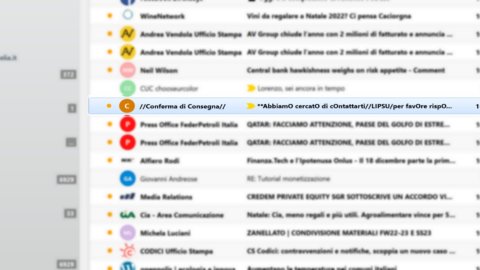I email scam attempts are now part of the daily life of anyone who has a digital life and, generally, when they do not automatically end up in the folder "spam“, these users immediately trash the one they recognize as Junk Mail already from the sender name or subject. Yet there are circumstances that make even those who are used to distinguishing scam emails at a glance vulnerable. One of these is certainly theconnection".
During the holidays, scammers know very well that the number of shipments and purchases on e-commerce portals is increasing dramatically. Sending emails for criminal purposes is therefore very convenient in this period. In fact, who is he? waiting for a parcel or instructions for sending it, it is considered normal to receive emails from one forwarder. The rush to close the file before the holiday on duty makes reading these emails very superficial.
Once upon a time, attempts to scam were truly pathetic (yet there were those who fell for it!): ungrammatical, the result of haphazard translations, not credible even graphically. Often, in trying to reproduce logos and brands of banks, postal services or goods of any kind, the scammers ended up unmasking themselves.
Today, it must be admitted, the Phishing has made great strides. Perhaps, that term may have also lost a certain semantic appropriateness, by virtue of its greater success. Certainly it is no longer comparable to the activity of that fisherman who randomly throws his net into the water in the hope of catching just one fish. Since the effort for casting is very small, small catches - if any - would justify any attempt anyway. In the early 2000s, phishing was an activity of this type: millions of emails sent literally at random without the slightest effort (perhaps even from a compromised computer) with a very low redemption, but still convenient. In fact, it was enough to put the evils on one or two credit card numbers, entered by the unsuspecting owner himself, to make the "game" profitable. In short, it is about the past; today phishing has its own strategy and can rely on important numbers of scams carried out.
Phishing is on the rise, especially around the holiday season
The reason? First of all, it has improved technically: these emails are no longer so easily captured by the spam filter, they are graphically pleasing, the Reproductions of logos range from “more than acceptable” to almost perfection. The sender's name is often disguised and not very suspicious. In short, today, even the most savvy are forced to pay more attention.
Still, there are weapons to defend against these scams, but they force users to be less impatient, a don't act on instinct, to reflect before doing anything and to put aside any kind of anxiety. The first remedy anti-fraud is outside the IT or technological sphere and relies on logic and common sense: to do something trivial consistency check. What does the package look like was shipped using the services of which forwarder? XXX? So why am I clicking on an email that has “Poste Italiane” as the sender? Since when does the notification for a parcel in storage arrive via email?
Maneuver of Security: controls to hinder identity theft attempts
La second “safety manoeuvre” is a little less immediate, but still has nothing to do with specialist studies of technical subjects: it is about hover above the button or above the link that you are invited to click. Any program of email, at this point, show the address complete with the page where you will be sent. It goes without saying that the URL must necessarily have a domain name (the first part of the address) consistent with the property of the service (Post, BRT, Amazon, UPS, etc…). Of course, with the smartphone, this verification is not within everyone's reach, but it is precisely in these situations that a computer must be seen as a sort of security system.
There is a third check we can do: the sender and recipient of these emails. They write to “xxx@yyy.zzz”, but I haven't given this email to anyone, let alone used it to register for any service! Certainly not to the one who sends me the notifies. The sender claims to be responsible for such and such a company's service, but has an @gmail.com account or worse of a service provider related to a foreign country which is not the one where my package should come from!
What to do if you have been a victim of phishing, the recommendations of the postal police
At this point, many will wonder with concern: "If I clicked on the links offered in the emails, what should I expect to happen"? We need to understand where we stopped. If you haven't entered your credentials on the scam-site, that's already something, but unfortunately our click certainly sent 2 confirmations to the scammers: the first is that that email exists, therefore that there is a person in the flesh, the second is that that person was waiting for a package or had to send one. Not only. In many cases, landing on a site that does not inform and does not give a choice on the type of processing of personal data of the user, allows the capture of further information on our habits, at least with regard to our recent searches on the Internet.
What to do immediately? Change the password of your mail account or, if not used, delete it completely from Internet. Statistically, this unfinished operation is what makes the Internet an unsafe place, why change Password to your own Email, so having to do it on all devices that connect to that account, is seen as a lengthy, sometimes complicated. Result? There are many web users, who are reading this article, who have come across such an email and, despite the doubt that someone may have compromised their mailbox, despite the recommendations of the Postal Police, it will do absolutely nothing.





